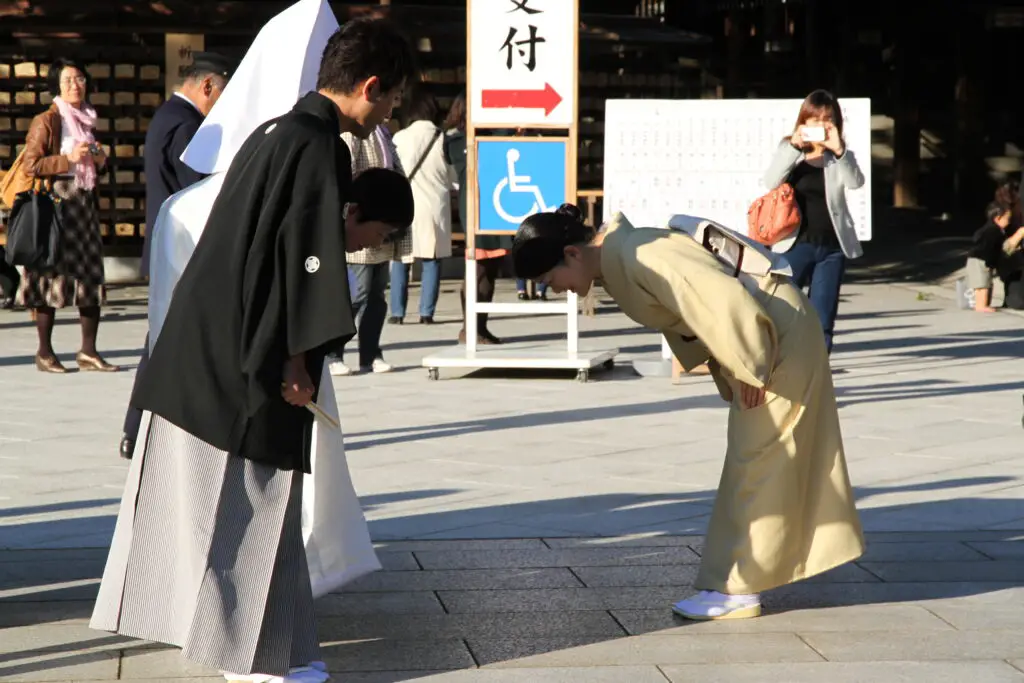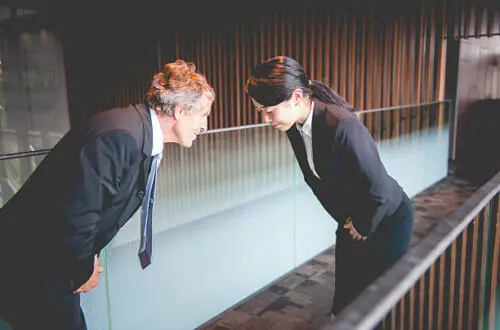
Honorific Titles in Japan: Why do Japanese Say San
Japan has a rich history and a very distinctive culture. One interesting thing that you’ve probably noticed is that they usually use titles, such as san, to refer to one another. But why do they do that, and why is it so important?
San is an honorific title that the Japanese use to address someone whom you aren’t that close with to show respect. If you wanted to call your boss named Mr. Haruki, you would say, ”I will call Haruki-san.” San is gender-neutral, and you usually (not always) use it to replace Mrs, Ms, and Mr.
However, san is just one out of many different Japanese honorific titles. In this article, we will cover many other titles, such as chan, kun, sama, and sensei. Moreover, you will learn more about the history of these titles and their importance. Without any further ado, let’s learn more about the fascinating culture of Japan through examining its titles.

The Sociolinguistic Importance of Japanese Honorific Titles
If you’re an avid Japanese culture admirer, you’ve probably noticed that the Japanese people have a very distinct way of referring to one another. They use different titles, depending on the context and the importance of the person they’re talking to. These titles act as suffixes that you attach to the end of the name (Haruki-san, Takahashi-san, etc.). All of this is a part of Keigo, which is also known as Japanese honorific speech.
Bear in mind, though, that these titles aren’t necessarily important grammar-wise. However, they are an essential part of Japanese culture. Japanese people value hierarchy, which is precisely what these titles represent. These suffixes can be applied to both first and last names, whichever is the last in the word order. As a general rule of thumb, you should always follow the Eastern Name Order when referring to Japanese names.

Hierarchy is the main reason why the Japanese use these suffixes. This distinction is based on criteria such as age or social status. For example, in a work setting, a person can be inferior, superior, or neutral. Consequently, each will receive a different title. However, some other factors come into play. Those include the following:
- Education
- Relationship with the person
- The level of trust between communicators
- Background
An important thing to note is that you should never use these titles when referring to yourself. There are some other rules you should be aware of, which we will go more in-depth about further in the article.
Formal Japanese Honorific Titles
San
San is probably the most well-known Japanese honorific title. You have likely heard of it at least once in your life, either through movies, anime, or speaking with someone. San is usually used when addressing someone directly. However, you can also use it when talking about someone who is not present in the conversation. Although you can use this honorific title to replace Mr, Ms, or Mrs, it also has other applications.
San is also gender-neutral, and speakers can use it to address classmates, company names, or their colleagues. For example, if an individual is referring to a business client (a company), they can also add the suffix -san. If the client is Facebook, per se, you will refer to them as Facebook-san. Although it might seem weird at first, the Japanese think that it’s rude not to honor their business partners.
Lastly, if someone uses san after your first name (e.g, Michael-san), it can mean that they feel connected to you but aren’t comfortable using your full name. The only time when the Japanese don’t use honorific titles is when they’re talking to their kids or closest friends.

Sama
Sama is among the most formal Japanese honorific titles. You commonly use it when referring to God or royalty. We can observe this title as the higher version of san. You can also use it to express the importance of clients in the customer service industry. English/American counterpart would be Sir, Madam, or Mister. Here are some other interesting applications:
- Oh-sama means ”King”
- Kami-sama means ”God”
- Okyaku-sama means ”Customer”
The Japanese have a firm belief that the customer is extremely important. That is precisely why they use -sama when addressing them. Actually, the word ”customer” translates to ”kyaku.” Adding -o before the word adds an even higher degree of respect (e.g., okyaku-sama).
If you use this title to refer to yourself, it shows arrogance, or it can have a sarcastic meaning. Lastly, -sama also appears in some phrases, for example:
- omachido-sama – Thank you for waiting
- otsukare-sama – Thanks for your good work
- gochiso-sama – Thank you for this meal
Informal Japanese Honorific Titles
Kun
Kun is usually used when people of senior social status address their juniors. Moreover, you can also use it for men (e.g. male children, male friends, boyfriend, etc.). Sometimes, you can use –kun to address women, but only in certain situations. That happens when the female person is a very close friend. Or, you can use it in a business situation, when you’re talking to a young female employee.
Although chan is the main way of referring to endearing individuals, using kun implies a more respectful relationship. Another interesting thing to note is what happens when you have two female individuals with the same name. In such cases, you can differentiate them by using -chan and -kun (e.g. Aika-chan and Aika-kun).
Chan
As we have briefly touched on before, chan is usually used as a diminutive. It expresses cuteness or childlikeness. It sounds similar to san, but with one letter change. Supposedly, this change happened because children couldn’t pronounce the word san correctly. If you use chan when referring to a superior, it is considered to be an insult.
Moreover, you can use this title to refer to adorable animals, especially cats. Although speakers shouldn’t use titles when talking about themselves, chan can be an exception. Sometimes, women would use chan when talking about themselves in third-person, to express cuteness.

Other Popular Japanese Honorific Titles
Tan
Tan is an even more endearing form of chan. It is similar to baby talk. For example, when kids can’t pronounce a word correctly. The Japanese rarely use it, except when talking to children or toddlers. If spoken to an adult, it can be received as an insult. Some characters in advertising have this title, such as Habanero-tan or Biscotto-tan.
Bo
Bo is another title that expresses cuteness. But, unlike previous ones, this one is meant for boys. It originates from the word ”obbochama” which means ”little lord.” Never use this title to address fully grown adult men.
Senpai
Senpai is a famous title because it’s often present in anime and manga. You use this title to refer to your superiors at schools, clubs, or workplaces. However, only a person that is more experienced than you can be addressed as senpai. Teachers, for example, are called sensei instead. Furthermore, this honorific title can stand on its own, without adding it to a name. You should never use senpai when talking about yourself. Senpai means that your status or wisdom should be recognized by others.

Kouhai
Kouhai is the complete opposite of senpai. It represents a junior, a person who holds a lower position, either at school, life, or work. This title depends on a person’s age and rank. However, kouhai and senpai are closely related. Senpais usually refer to their students or inferiors as kouhai.
Sensei
Sensei is another honorific title which is quite famous worldwide. If you’ve ever watched Karate Kid, then you must have heard about this suffix as well. However, you can use sensei on its own, without attaching it to a name. This word means ”teacher.” You use it to refer to an authority figure that is a master of their skill (doctor, teacher, artist, etc.).
Hakase
Hakase means ”professor” and you usually use it to refer to someone with extensive academic expertise.
Shi
Next, we will talk about the title shi. This particular title is present in written language or in formal speech. The speaker would refer to an unfamiliar person as shi. This word is especially recurrent with newsreaders, for example. Moreover, you can find it in:
- academic journals
- legal documents
- other formal writing styles
Furthermore, you can use shi alone, without adding neither a first or the last name before.
Tono
Tono is another suffix that translates to ”master” or ”lord.” You should commonly pronounce it as dono, which how they sometimes write it as well. However, you don’t use tono to express royalty or noble status. Instead, it is more similar to the English word ”milord.” You won’t hear this term often in daily conversation. Sometimes, you may find it in formal writing, such as awards or certificates. You can also use it during famous tea ceremonies.
No Kimi
No kimi is a historical Japanese honorific title. People used to use it to address lords or ladies of the court. This was especially popular during the Heian period. You might have heard it in ”The tale of Genji,” a popular book. The main protagonist, Prince Hikaru Genji was known as Hikaru no Kimi. In modern Japanese language, you use this title in historical dramas or when someone is acting spoiled.
Ue
Lastly, we will talk about the title ue. This title expresses a very high level of respect for someone. In literal translation, this word means ”above.” However, in modern language, the Japanese seldom use it. Sometimes, you can find it in words, such as ane-ue (older sister), chichi-ue (father), or haha-ue (mother).
Familiar Japanese Honorific Titles

Below, you will find a list of common Japanese familial honorific titles:
- Ka (mother) – Oka-san (formal version), Ka-san, or Ka-chan (informal version).
- To (father) – Oto-san (formal version), To-san (informal version).
- Ba (grandma) – Oba-san (formal version), Oba-chan (informal version).
- Ji (grandpa) – Oji-san (formal version), Oji-chan (informal version).
- Ba (aunt, middle-aged woman) – Oba-san (formal version).
- Ji (uncle, middle-aged man) – Oji-san (formal version).
- Nii (older brother) – Onii-san, Nii-san (formal version), Onii-chan, Nii-chan, Nii-san (informal version).
- Ne (older sister) – One-san, Ne-san (formal version), One-chan, Ne-chan, Ne-san (informal version).
Understanding the Yobisute Concept
The Yobisute concept deals with adding suffixes when addressing someone else. This concept is closely related to everything we’ve been talking about so far. It expresses a degree of respect and intimacy. So, why is Yobisute so important? Understanding this concept will help with understanding honorific titles with more ease.
The Japanese language has an in-out (uchi-soto) concept, which rules their speech. Uchi means home, while Soto means outside. Consequently, uchi refers to individuals inside a social circle (e.g. family, clubs, etc.). On the other hand, soto refers to all individuals that are outside that social circle.
These titles depend on the relationship between the communicator and the person they’re addressing. As a general rule, you should use different titles when talking to someone from soto and uchi.
Japanese Workplace Titles

Sometimes, in a Japanese work setting, you may need to use work titles instead of honorific. Although this might seem confusing, we’re here to simplify it. Here is a list of important work-related titles in Japan:
- Buchou – General manager
- Kachou – Section Manager
- Kaichou – Chairman or President
- Shachou – Company President
When You Should and Shouldn’t Use These Titles
The Japanese honorific title system is quite complex, especially for foreigners. As a visitor, you want to respect the country’s traditions. However, sometimes you might unknowingly offend someone when trying to use titles to address them. To prevent this from happening, we will clarify some things. You should never use honorific titles when:
- Referring to yourself – it expresses arrogance and egoism
- When someone asks you not to use titles when talking to them
- If you’re talking to a very close friend or family
- When talking about your close circle of friends and family to someone outside your social circle
As a foreigner, you should do your best to respect these rules. Moreover, don’t take it the wrong way if someone doesn’t use a title next to your name. Using the first name when talking to a Japanese person might make them feel uncomfortable. However, in business, you should always use respective titles. Spending time with the Japanese and learning more about their culture will make this honorific title system much easier to grasp.
Related Questions
Do you use San with first or last names?
When using san in combination with the first name, it expresses closeness and a friendly relationship. When you use san in combination with last names, it expresses respect and formality. You should always use it in business or formal speech. On the other hand, it’s not necessary to use it when talking to close friends and family.
Why do the Japanese use their last names first?
In Japanese culture, the name order is contrasting to the Western model. That means that the last name goes before the first name. Moreover, unless you’re very close to someone, you should always call them by their last name.
Is San in Japanese gender-specific?
San is gender-neutral. You can use it to refer to both female and male individuals. It usually means Mr, Mrs, or Ms.
Why do the Japanese say hello twice?
This is a common question, especially for foreigners. The Japanese say moshi moshi when saying hello or answering the phone. This has a long tradition that relates to ghosts and ghouls in Japanese culture. Historically, saying moshi moshi twice would prove that you are not a ghost. Supposedly, ghosts can only pronounce moshi once.
Is it rude to shake hands in Japan?
Japanese people usually greet each other with a bow. It ranges from a deep bow to just a head nod. This greeting expresses respect. You should also bow when thanking someone, apologizing, or asking for a favor. However, most Japanese understand that foreigners aren’t aware of these customs. So, they will accept a handshake, especially in an international business setting. Hand gestures are very common in Japan, and they always have different meanings (fist bump, thumbs up, etc).
Is it rude to hug in Japan?
Although the Japanese are very kind people, they like their distance. It is best to avoid kissing or hugging the Japanese, especially if you aren’t close to the person. Moreover, they don’t appreciate public displays of affection, such as smooching.
Conclusion
Japanese culture is very unique and beautiful. This country is very respectful and appreciates hierarchy. Although their honorific title system might seem daunting or confusing, you will learn it eventually. The Japanese use different types of titles for a lot of things. They have specific titles for criminals, companies, martial artists, etc. In this article, though, we’ve mostly covered honorific titles. We’ve ensured to talk about the most important points, rules, and meanings.
As difficult as it may seem, the more you use these titles, the easier it will get. If you’re a foreigner in Japan, you can always seek advice from locals, to ensure that you’re addressing people correctly. As they say, ”When in Rome, do as the Romans do.”





